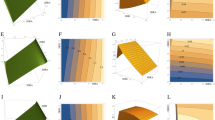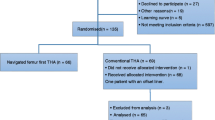Abstract
Purpose
Accurate assessment of cup orientation on postoperative radiographs is essential for evaluating outcome after THA. However, accuracy is impeded by the deviation of the central X-ray beam in relation to the cup and the impossibility of measuring retroversion on standard pelvic radiographs.
Method
In an experimental trial, we built an artificial cup holder enabling the setting of different angles of anatomical anteversion and inclination. Twelve different cup orientations were investigated by three examiners. After comparing the two methods for radiographic measurement of the cup position developed by Lewinnek and Widmer, we showed how to differentiate between anteversion and retroversion in each cup position by using a second plane. To show the effect of the central beam offset on the cup, we X-rayed a defined cup position using a multidirectional central beam offset. According to Murray’s definition of anteversion and inclination, we created a novel corrective procedure to balance measurement errors caused by deviation of the central beam.
Results
Measurement of the 12 different cup positions with the Lewinnek’s method yielded a mean deviation of \(1.8{^{\circ }}\) (95 % CI 1.3–2.3) from the original cup anteversion. The respective deviation with the Widmer/Liaw’s method was \(3.2{^{\circ }}\) (95 % CI 2.4–4.0). In each case, retroversion could be differentiated from anteversion with a second radiograph. Because of the multidirectional central beam offset (\({\pm }5\) cm) from the acetabular cup in the cup holder (\(25{^{\circ }}\) anteversion and \(36{^{\circ }}\) inclination), the mean absolute difference for anteversion was \(3.9{^{\circ }}\) (range \(-4.2{^{\circ }}\) to \(+4.0{^{\circ }})\) and \(0.7{^{\circ }}\) (range \(-1.2{^{\circ }}\) to \(+1.2{^{\circ }})\) for inclination. The application of our novel mathematical correction of the central beam offset reduced deviation to a mean difference of \(0.4{^{\circ }}\) for anteversion and \(0.3{^{\circ }}\) for inclination.
Conclusion
This novel calculation for central beam offset correction enables highly accurate measurement of the cup position.







Similar content being viewed by others
References
Ackland MK, Bourne WB, Uhthoff HK (1986) Anteversion of the acetabular cup. Measurement of angle after total hip replacement. J Bone Joint Surg Br 68:409–413
Craiovan B, Renkawitz T, Weber M, Grifka J, Nolte L, Zheng G (2014) Is the acetabular cup orientation after total hip arthroplasty on a two dimension or three dimension model accurate? Int Orthop. 38:2009–2015
D’Lima DD, Urquhart AG, Buehler KO, Walker RH, Colwell CW Jr (2000) The effect of the orientation of the acetabular and femoral components on the range of motion of the hip at different head-neck ratios. J Bone Joint Surg Am 82:315–321
Derbyshire B (2008) Correction of acetabular cup orientation measurements for X-ray beam offset. Med Eng Phys 30:1119–1126
Derbyshire B, Diggle PJ, Ingham CJ, Macnair R, Wimhurst J, Jones HW (2014) A new technique for radiographic measurement of acetabular cup orientation. J Arthroplasty 29:369–372
Ghelman B, Kepler CK, Lyman S, Della Valle AG (2009) CT outperforms radiography for determination of acetabular cup version after THA. Clin Orthop Relat Res 467:2362–2370
Kalteis T, Handel M, Herold T, Perlick L, Paetzel C, Grifka J (2006) Position of the acetabular cup—accuracy of radiographic calculation compared to CT-based measurement. Eur J Radiol 58:294–300
Lequesne MG, Laredo JD (1998) The faux profil (oblique view) of the hip in the standing position. Contribution to the evaluation of osteoarthritis of the adult hip. Ann Rheum Dis 57:676–681
Leunig M, Ganz R (1998) The Bernese method of periacetabular osteotomy. Orthopade 27:743–750
Lewinnek GE, Lewis JL, Tarr R, Compere CL, Zimmerman JR (1978) Dislocations after total hip-replacement arthroplasties. J Bone Joint Surg Am 60:217–220
Liaw CK, Hou SM, Yang RS, Wu TY, Fuh CS (2006) A new tool for measuring cup orientation in total hip arthroplasties from plain radiographs. Clin Orthop Relat Res 451:134–139
Liaw CK, Yang RS, Hou SM, Wu TY, Fuh CS (2009) Measurement of the acetabular cup anteversion on simulated radiographs. J Arthroplasty 24:468–474
Little NJ, Busch CA, Gallagher JA, Rorabeck CH, Bourne RB (2009) Acetabular polyethylene wear and acetabular inclination and femoral offset. Clin Orthop Relat Res 467:2895–2900
Lu M, Zhou YX, Du H, Zhang J, Liu J (2013) Reliability and validity of measuring acetabular component orientation by plain anteroposterior radiographs. Clin Orthop Relat Res 471:2987–2994
Malik A, Wan Z, Jaramaz B, Bowman G, Dorr LD (2010) A validation model for measurement of acetabular component position. J Arthroplasty 25:812–819
Marx A, von Knoch M, Pfortner J, Wiese M, Saxler G (2006) Misinterpretation of cup anteversion in total hip arthroplasty using planar radiography. Arch Orthop Trauma Surg 126:487–492
Murray DW (1993) The definition and measurement of acetabular orientation. J Bone Joint Surg Br 75:228–232
Nho JH, Lee YK, Kim HJ, Ha YC, Suh YS, Koo KH (2012) Reliability and validity of measuring version of the acetabular component. J Bone Joint Surg Br 94:32–36
Nomura T, Naito M, Nakamura Y, Ida T, Kuroda D, Kobayashi T, Sakamoto T, Seo H (2014) An analysis of the best method for evaluating anteversion of the acetabular component after total hip replacement on plain radiographs. Bone Joint J 96B:597–603
Patil S, Bergula A, Chen PC, Colwell CW Jr, D’Lima DD (2003) Polyethylene wear and acetabular component orientation. J Bone Joint Surg Am 85–A(Suppl 4):56–63
Pradhan R (1999) Planar anteversion of the acetabular cup as determined from plain anteroposterior radiographs. J Bone Joint Surg Br 81:431–435
Preininger B, Haschke F (2014) Diagnostics and therapy of luxation after total hip arthroplasty. Orthopade 43:54–63
Renkawitz T, Weber M, Springorum HR, Sendtner E, Woerner M, Ulm K, Weber T, Grifka J (2015) Impingement-free range of movement, acetabular component cover and early clinical results comparing ’femur-first’ navigation and ’conventional’ minimally invasive total hip arthroplasty: a randomised controlled trial. Bone Joint J 97–B:890–898
Shin WC, Lee SM, Lee KW, Cho HJ, Lee JS, Suh KT (2015) The reliability and accuracy of measuring anteversion of the acetabular component on plain anteroposterior and lateral radiographs after total hip arthroplasty. Bone Joint J 97–B:611–616
Tannast M, Murphy SB, Langlotz F, Anderson SE, Siebenrock KA (2006) Estimation of pelvic tilt on anteroposterior X-rays-a comparison of six parameters. Skeletal Radiol 35:149–155
Wan Z, Malik A, Jaramaz B, Chao L, Dorr LD (2009) Imaging and navigation measurement of acetabular component position in THA. Clin Orthop Relat Res 467:32–42
Weber M, Lechler P, von Kunow F, Vollner F, Keshmiri A, Hapfelmeier A, Grifka J, Renkawitz T (2015) The validity of a novel radiological method for measuring femoral stem version on anteroposterior radiographs of the hip after total hip arthroplasty. Bone Joint J 97–B:306–311
Widmer KH (2004) A simplified method to determine acetabular cup anteversion from plain radiographs. J Arthroplasty 19:387–390
Woo RY, Morrey BF (1982) Dislocations after total hip arthroplasty. J Bone Joint Surg Am 64:1295–1306
Yoon YS, Hodgson AJ, Tonetti J, Masri BA, Duncan CP (2008) Resolving inconsistencies in defining the target orientation for the acetabular cup angles in total hip arthroplasty. Clin Biomech 23:253–259
Zheng G, von Recum J, Nolte LP, Grutzner PA, Steppacher SD, Franke J (2012) Validation of a statistical shape model-based 2D/3D reconstruction method for determination of cup orientation after THA. Int J Comput Assist Radiol Surg 7:225–231
Acknowledgments
We thank Monika Schoell for the linguistic revision of our manuscript.
Author information
Authors and Affiliations
Corresponding author
Ethics declarations
Conflict of interest
The authors declare that they have no conflict of interest.
Human and animal rights
This article does not contain any studies with human participants or animals.
Additional information
An erratum to this article is available at http://dx.doi.org/10.1007/s11548-017-1525-5.
Electronic supplementary material
Below is the link to the electronic supplementary material.

Appendix
Appendix
Vertical and horizontal correction for central beam deviation
To assess and correct cup position, we used a self-designed Microsoft Excel sheet (see supplementary material) and the calculations shown below. The following parameters are required and exemplarily measured in Fig. 5. For X-ray setting of pelvic radiographs, we added a 3D sketch (see supplementary material) that shows how to measure the vertical and horizontal X-ray offset angle.
Radiographic anteversion (RA) is calculated using s and l. Radiographic inclination (RI) is measured as the angle between the horizontal line of the pelvis and the continued line of the long diameter of the cup. The horizontal and vertical offset angle \((X_{\mathrm{angle}},Y_{\mathrm{angle}})\) is calculated by means of the trigonometric relation between the X-ray offset (X, Y) and the focus object distance \((\hbox {FO}=85\,\hbox {cm})\).
Horizontal correction-first step
Radiographic anteversion (RA) and inclination (RI) are transformed to the anatomical definition (AA and AI) according to Murray:
The error due to horizontal offset is balanced by adding the angle of horizontal X-ray offset to anatomical anteversion (AA):
Anatomical inclination (AI) is not affected by horizontal X-ray offset; thus, correction is not necessary.
Vertical correction-second step
Horizontally corrected anteversion \((\hbox {AA}_{\mathrm{Xcorr}})\) is transformed to the operative definition \((\hbox {OA}_{\mathrm{Xcorr}})\) according to Murray:
By subtracting the angle of vertical X-ray offset (\(Y_{\mathrm{angle}})\) from operative anteversion (\(\hbox {OA}_{\mathrm{Xcorr}})\), the error due to horizontal offset is balanced, and horizontally and vertically corrected operative anteversion (\(\hbox {OA}_{\mathrm{XYcorr}})\) is calculated:
Operative inclination is not influenced by vertical X-ray offset and calculated according to Murray from horizontally corrected anteversion \((\hbox {AA}_{\mathrm{Xcorr}})\) and anatomical inclination (AI).
Finally, horizontally and vertically corrected operative definition of anteversion \((\hbox {OA}_{\mathrm{XYcorr}})\) and inclination \((\hbox {OI}_{\mathrm{XYcorr}})\) is retransformed to the radiographic or the anatomical definition according to Murray. Because we set the anatomical definition with our cup holder, we calculated anatomical anteversion and inclination to validate the corrective procedure:
Rights and permissions
About this article
Cite this article
Schwarz, T., Weber, M., Wörner, M. et al. Central X-ray beam correction of radiographic acetabular cup measurement after THA: an experimental study. Int J CARS 12, 829–837 (2017). https://doi.org/10.1007/s11548-016-1489-x
Received:
Accepted:
Published:
Issue Date:
DOI: https://doi.org/10.1007/s11548-016-1489-x




